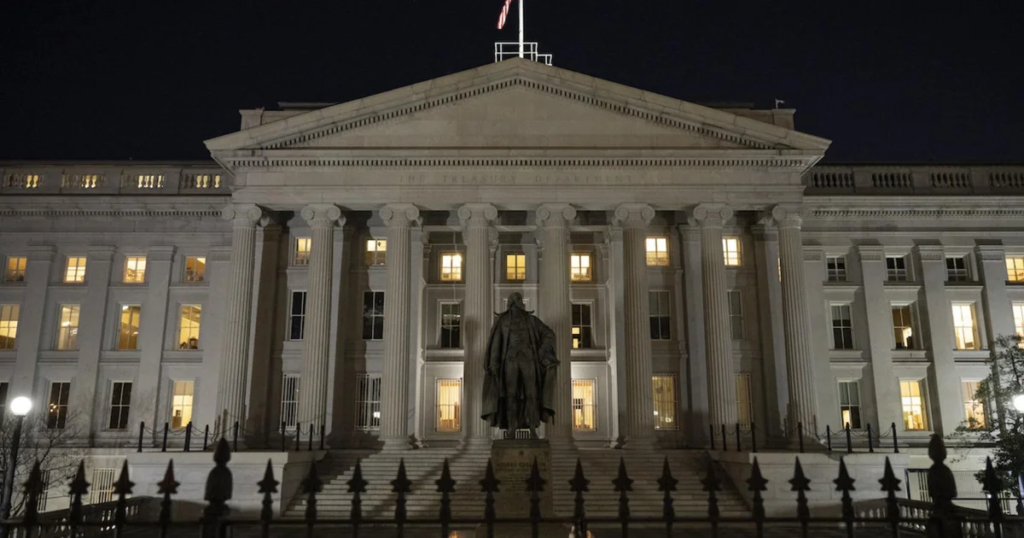In a significant cybersecurity incident, the U.S. Treasury Department has confirmed that Chinese state-sponsored hackers infiltrated its systems through a sophisticated phishing campaign targeting a third-party contractor. The breach, described as a “major incident,” compromised unclassified systems, including workstations and sensitive documents, raising concerns about national security and the vulnerability of federal networks. This article explores the details of the breach, its implications, and the broader context of Chinese cyberattacks targeting U.S. infrastructure.

Details of the Treasury Breach
On December 8, 2024, the Treasury Department was notified by BeyondTrust, a third-party cybersecurity service provider, of a security breach that allowed hackers to access Treasury systems. The attackers, identified as part of the Chinese state-backed hacking group Silk Typhoon (also known as UNC5221), exploited a stolen digital key to infiltrate BeyondTrust’s remote technical support platform. This breach enabled access to over 400 workstations, including those of senior officials like Treasury Secretary Janet Yellen, Deputy Secretary Wally Adeyemo, and Acting Under Secretary Brad Smith.
The hackers accessed more than 3,000 unclassified files, including sensitive data related to the Committee on Foreign Investment in the United States (CFIUS), which reviews foreign investments for national security risks, and the Office of Foreign Assets Control (OFAC), responsible for administering sanctions. While classified systems and email networks remained unaffected, the breach targeted high-value information, such as policy documents, organizational charts, and materials related to sanctions and international affairs. The Treasury Department acted swiftly, disconnecting BeyondTrust’s systems and collaborating with the Cybersecurity and Infrastructure Security Agency (CISA), the FBI, and other federal agencies to investigate and mitigate the incident.
How the Phishing Campaign Worked
The breach stemmed from a phishing campaign that compromised BeyondTrust, a Georgia-based software contractor providing remote support services to the Treasury. Phishing campaigns typically involve fraudulent emails or messages designed to trick users into revealing sensitive information, such as login credentials or digital keys. In this case, the hackers used a stolen BeyondTrust API key to gain unauthorized access to the Treasury’s unclassified systems. This incident highlights the growing threat of supply chain attacks, where hackers target third-party vendors to infiltrate larger organizations.
According to cybersecurity experts, Silk Typhoon is known for its sophisticated tactics, including the use of zero-day vulnerabilities and tools like the China Chopper web shell for reconnaissance and data theft. The group’s focus on third-party providers underscores the vulnerability of federal contractors, which often serve as weaker links in the cybersecurity chain. The Treasury breach is part of a broader pattern of Chinese cyberattacks exploiting IT supply chains to target U.S. government agencies and critical infrastructure.

Broader Context of Chinese Cyber Operations
The Treasury breach is not an isolated incident but part of a series of Chinese state-sponsored cyberattacks targeting U.S. institutions. In 2023, hackers accessed over 150,000 emails from the Treasury’s Office of the Comptroller of the Currency (OCC), compromising sensitive financial oversight information. Earlier incidents also targeted email accounts of senior officials, including Commerce Secretary Gina Raimondo and U.S. Ambassador to China Nicholas Burns. These attacks demonstrate a persistent effort by Chinese hacking groups, such as Silk Typhoon, Salt Typhoon, and Volt Typhoon, to gather intelligence and disrupt U.S. operations.
In March 2025, the U.S. Department of Justice charged 12 Chinese nationals, including two officers of China’s Ministry of Public Security, for their involvement in the Treasury breach and other cyberattacks targeting over 100 U.S. organizations. The defendants, linked to the hacking group APT27 (also known as Silk Typhoon), allegedly worked with private contractors like Anxun Information Technology Co. and Shanghai Heiying Information Technology Company to obscure the Chinese government’s involvement. The Justice Department revealed that these hackers were paid up to $75,000 per compromised email inbox, targeting a wide range of entities, including technology companies, think tanks, defense contractors, and universities.
The U.S. government has responded with sanctions and criminal charges. In January 2025, the Treasury Department imposed sanctions on Yin Kecheng, a key hacker involved in the breach, and Sichuan Juxinhe Network Technology Co., a company tied to China’s Ministry of State Security. The State Department also offered a $10 million reward for information leading to the apprehension of the hackers, who remain at large.
Implications for National Security
The Treasury breach raises significant concerns about the security of unclassified but sensitive information. While the hackers did not access classified systems, the stolen data could be pieced together to produce valuable intelligence, particularly regarding U.S. sanctions and foreign investment policies. The targeting of CFIUS and OFAC suggests an intent to gather information on Chinese entities potentially facing U.S. sanctions, which could undermine American economic and diplomatic strategies.
Moreover, the breach highlights the vulnerability of federal contractors in the face of advanced cyber threats. Third-party vendors like BeyondTrust often have access to critical systems, making them prime targets for hackers. The Treasury Department has expressed concerns about BeyondTrust’s cooperation during the investigation and is exploring alternative providers to strengthen its cybersecurity posture. This incident underscores the need for robust vendor oversight and enhanced cybersecurity measures across government agencies.

Government and Industry Response
The U.S. government has taken decisive steps to address the breach. Treasury officials briefed lawmakers in January 2025, emphasizing the scale of the incident and the need for improved cybersecurity. The FBI seized virtual private servers used by the hackers, and CISA confirmed that the breach did not affect other federal agencies. However, the incident has prompted calls for stronger regulations on federal contractors and increased investment in cybersecurity infrastructure.
On the industry side, BeyondTrust has faced scrutiny for its role in the breach. The company, which holds contracts worth over $4 million with the federal government, has been criticized for failing to prevent the compromise of its systems. This has sparked a broader discussion about the responsibility of third-party vendors to secure government data and the need for stricter cybersecurity standards in federal contracts.
What’s Next for Cybersecurity in the U.S.?
The Treasury breach serves as a wake-up call for the U.S. government to bolster its defenses against state-sponsored cyberattacks. Experts recommend several measures to prevent future incidents, including:
- Enhanced Vendor Oversight: Federal agencies must implement stricter cybersecurity requirements for third-party contractors, including regular audits and penetration testing.
- Advanced Threat Detection: Investing in AI-driven cybersecurity tools can help detect and respond to phishing campaigns and supply chain attacks in real time.
- Public-Private Collaboration: Strengthening partnerships between government agencies and private cybersecurity firms can improve threat intelligence sharing and response capabilities.
- Employee Training: Regular training on recognizing phishing attempts can reduce the risk of human error, a common entry point for cyberattacks.
As Chinese hacking groups continue to target U.S. infrastructure, the government faces increasing pressure to act decisively. The Treasury breach, combined with other incidents like the Salt Typhoon attack on telecommunications companies, underscores the need for a comprehensive national cybersecurity strategy to protect critical systems and sensitive data.
Conclusion
The U.S. Treasury Department’s confirmation of a Chinese state-sponsored phishing campaign targeting its systems through a federal contractor highlights the growing threat of cyberattacks on government institutions. While the breach did not compromise classified systems, the theft of sensitive unclassified data raises serious concerns about national security and the integrity of federal networks. As the U.S. government works to address this incident and prevent future breaches, the focus must remain on strengthening cybersecurity, enhancing vendor accountability, and staying vigilant against sophisticated adversaries like Silk Typhoon. The stakes are high, and the need for robust defenses has never been clearer.
For more information on this incident, visit Reuters or Bloomberg.
Also know :- Measles Cases Surge in 15 U.S. States Amid Anti-Vaccine Misinformation Campaigns






